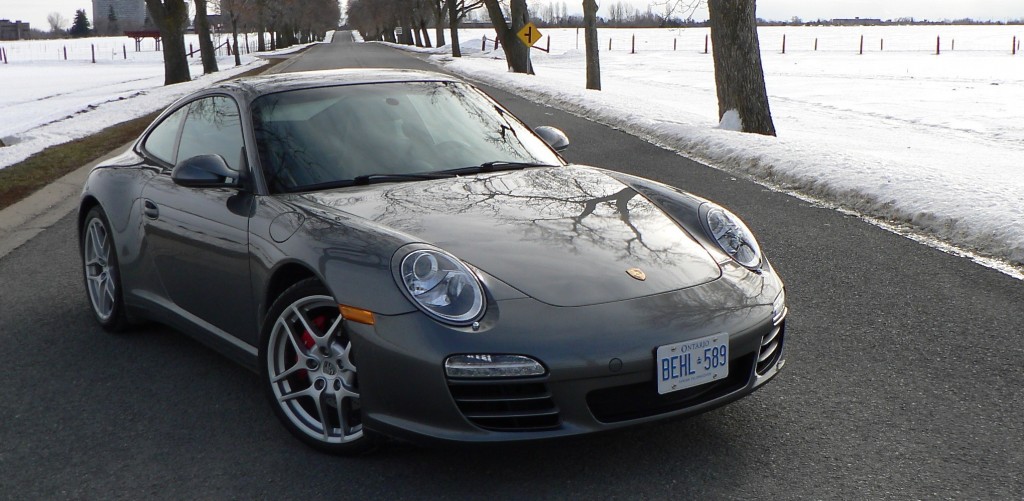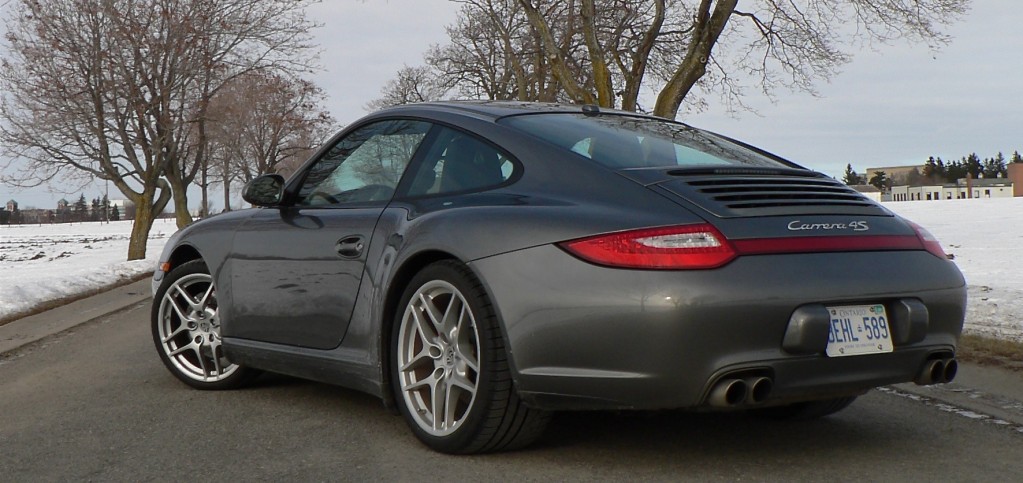Road Test: 2009 Porsche 911 Carrera 4S
Story and photos by John LeBlanc
Some automakers take a few too many liberties in labeling their sports cars as “everyday” transportation. For instance, Audi likes to brag that its R8 can be driven 365 days a year, mainly because it has all-wheel-drive. I guess so. But what if that day falls in January. In Winnipeg. In a forty-below, call-in-the-Mounties blizzard? My bets are the R8 is safely tucked away in the Audi owner’s heated garage.
Which brings us to Porsche’s all-wheel-drive version of its 911 Camera S, updated for 2009. Is there a better all-around sports car you can drive everyday between January 1 and December 31?
Porsche piles on the refinement for 2009
For 2009, Porsche has applied one of its methodical, mid-cycle updates to its 911 Carrera lineup. Based on the internally coded 997-platform that debuted in 2004, new direct-injection engines to increase power and economy and dual-clutch transmissions are the most noteworthy improvements.
Granted, it’s hard to call any car that has a price starting over one hundred big ones as “everyday.” But compared to some AWD rivals ($141,000 Audi R8 4.2; $130,500 Mercedes-Benz CL 550 4MATIC) the Porsche is a relatively good value. My 911 Carrera 4S tester—4 is for four-wheel drive, S for the larger and more powerful 3.8-litre flat-six (over the standard 3.6— starts at $115,000, and ranks just below the $161,700 AWD Turbo in the 911 pecking order. Externally, Porsche adds the 44 mm wider Turbo rear fenders and a red reflective strip between the tail lights to distinguish its all-wheel-drive 911s (there’s also a $127,800 convertible iteration) from its rear-wheel-drive models.
Porsche says the 911’s pair of new flat-sixes represents a significant step forward for the German automaker. They are six kilogram lighter and have about 40 per cent less moving parts. A smaller stroke with a larger bore, direct fuel injection, and higher compression ratios (up to 12.5:1 on the 4S) are also part of the engine department upgrades.
As such, the 911 4S gains 30 hp over the last model—now totaling 385 hp—plus an additional 15 lb-ft of torque (now 310.) However, its fuel consumption is a still reasonable 15.7L/100 km city, 7.6 hwy. Opt for the new $5,560 PDK dual-clutch auto gearbox, and the numbers are nearly identical: 15.8L/7.5L.
Pure sports car performance, plus daily driving convenience
No matter how many—or which—wheels are being powered, a 911 flat-six at full song is an aural delight. And now it’s quicker than ever. While Porsche reports a 0-100 km/h time of only 4.7 seconds (same as the R8) if you add the optional $1,310 Sport Chrono Package Plus, a launch-control feature aids the Carrera 4S to shave 0.3 seconds from that time—equaling the previous 911 GT3. Straight-line acceleration aside, it’s the combination of AWD and the new PDK that make the 911 4S such an easy car to drive all year round.
Replacing last year’s optional six-speed Tiptronic S shift-for-yourself automatic transmission, Porsche calls its new autobox “Doppelkupplungsgetriebe” (or PDK)—German for double-clutch gearbox.
Dual-clutch automatic gearboxes are a relatively new type of transmission. And Porsche has taken its time to jump onto the dual-clutch bandwagon. But the wait seems to have been worth it. The beauty of these boxes lies in that they match the convenience of not having to use a clutch pedal with the ability to shift gears faster than humanly possible with a manual gearbox. Essentially, there are two electronically controlled clutches and two drive shafts, but only one output shaft—all in one housing. When shifting from one gear to another in a dual-clutch gearbox, the next gear is already in mesh—ready to go. Beyond the loss of the clutch pedal, benefits include immediate cog-swapping action normally found only in driving video games, and uninterrupted power to the driving wheels.
You can customize PDK to your driving mood via three settings. Left alone in D for more relaxed driving, it acts like a sporty autobox, up shifting early. Hit the Sport button, and shifts are now held longer and downshifts are quicker as well. The Sports Chrono package adds an additional Sport Plus setting, which holds gears even longer and quickens throttle response. While fun for a awhile on public roads, Sport Plus is best suited for track day use. Too bad, then, Porsche missed the boat when it came to how the driver interests with PDK.
Instead of the more intuitive paddle shifters, separated from the steering wheel (and quickly becoming the industry standard) Porsche has hung onto its old configuration carried over form the last Tiptronic. Shift buttons are mounted in the steering wheel spokes. Instead of a dedicated “left, shift down/right, shift up” scenario, you can shift up or down on both sides. Ultimately unintuitive, disappointing and something Porsche needs to fix.
All-wheel-drive equals all-weather driving fun
When the first all-wheel-drive 911 arrived in 1990—fashioned after the system first seen in the low-volume 959 super car—Porsche diehards pooh-poohed the idea. Real drivers oversteered into the bushes, or so the credo went. But for those who truly wanted to enjoy their sports car year round, and lived north of Phoenix, Orlando or Milan, traction at all four wheels was seen as a godsend.
The updated system in the 2009 911 4S is the same found in the 911 Turbo. Now electronically controlled, instead of the old version’s viscous coupling for the centre differential there is an electromagnetically controlled multi plate clutch, with a 22 per cent limited slip differential now fitted as standard on the rear axle. Never mind the technical nuts and bolts, on any surface, the 4S’s new AWD makes the driver feel more confident—regardless of the road or weather condition. And where previous AWD 911s lacked the surgically precise steering that the RWD versions were blessed with, the 2009 4S is almost the equal. Toss in the traditionally class-leading Porsche brakes, plus tons of grip and tactile messages from the suspension, and the 911 4S becomes an extraordinary driving experience. Even in February. In Ottawa. In an ice storm.
Practically perfect
Hey—I haven’t even mentioned that the 2009 911 Carrera 4S offers the practicality of those extra rear seats (that can be used for additional cargo room to the front trunk if only two are on board.) Or that the 911’s iconic shape, one that Porsche hasn’t really messed with for over 45 years, blends easily into day to day traffic.
For a sports car, how “everyday” is that?
2009 Porsche 911 Carrera 4S
Base price: $120,560
Type of vehicle: AWD compact 2+2 sports car
Engine: 1.5L, 16-valve DOHC I4
Power/torque: 385 hp/310 lb.-ft.
Transmission: Six-speed manual (opt. dual-clutch sequential automatic)
0-100 km/h: 4.7 seconds
Fuel consumption: (city/hwy., est.): 6M 15.7/7.6 L/100 km; PDK 15.8/7.5 L/100 km
Competition: Audi R8 4.2, Mercedes-Benz CL 550 4MATIC
ROAD TEST SUMMARY
PROS
-World-class steering, handling and performance.
-All-weather traction
-Sophisticated transmission
CONS
-Unintuitive PDK shift buttons
-As common as Tim Bits







![[del.icio.us]](https://www.straight-six.com/wp-content/plugins/bookmarkify/delicious.png)
![[Digg]](https://www.straight-six.com/wp-content/plugins/bookmarkify/digg.png)
![[Facebook]](https://www.straight-six.com/wp-content/plugins/bookmarkify/facebook.png)
![[Google]](https://www.straight-six.com/wp-content/plugins/bookmarkify/google.png)
![[Reddit]](https://www.straight-six.com/wp-content/plugins/bookmarkify/reddit.png)
![[StumbleUpon]](https://www.straight-six.com/wp-content/plugins/bookmarkify/stumbleupon.png)
![[Twitter]](https://www.straight-six.com/wp-content/plugins/bookmarkify/twitter.png)
![[Email]](https://www.straight-six.com/wp-content/plugins/bookmarkify/email.png)